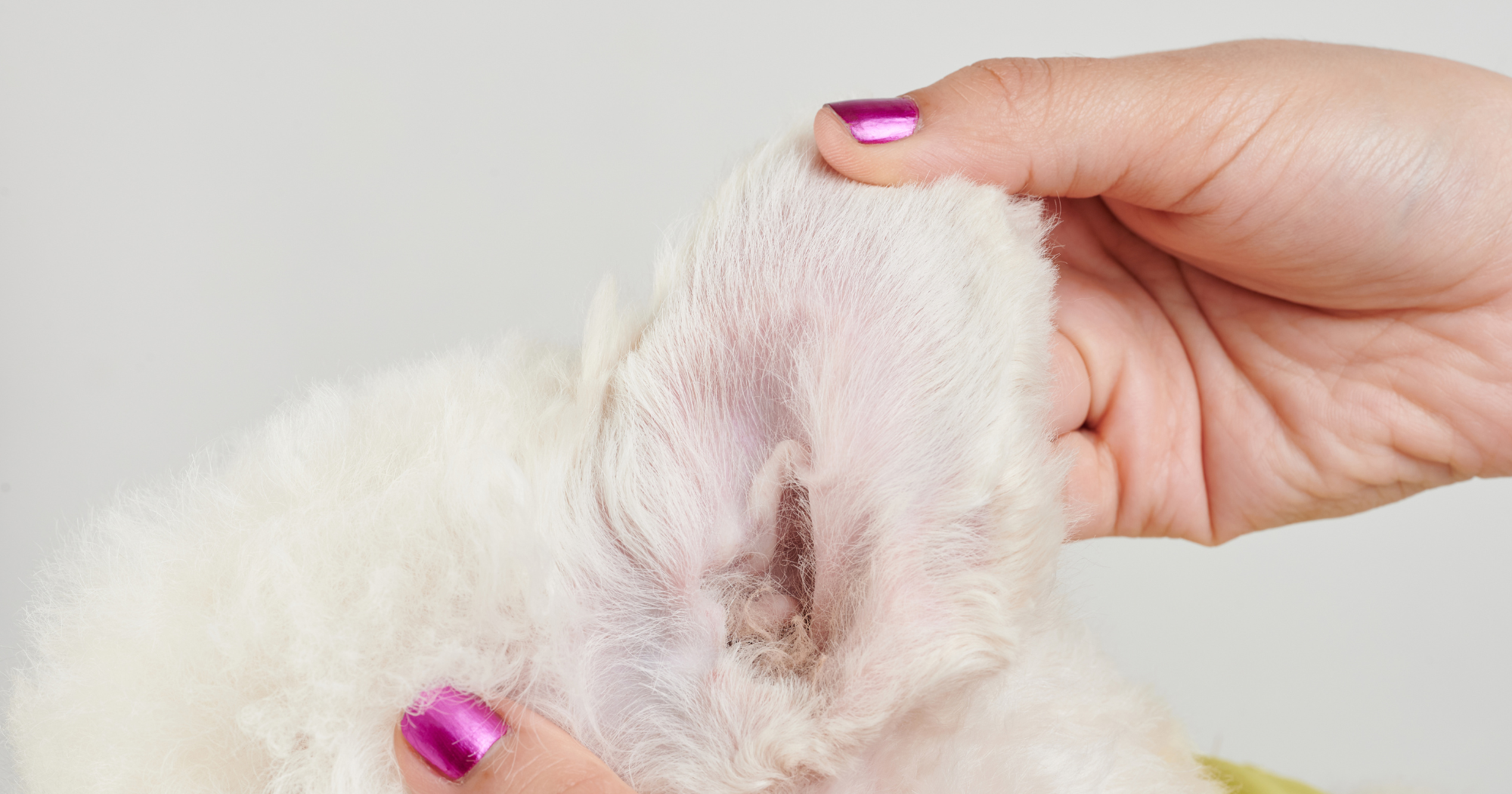
Imagine your furry best friend incessantly scratching, uncomfortable and distressed. Behind this distress could lie a tiny yet formidable foe: fleas and ticks, lurking in the shadows of your pet’s coat. These pests are not just a nuisance; they carry diseases that can severely impact your dog’s health and well-being. As a responsible pet owner, understanding and combating these pernicious parasites is crucial for your dog’s comfort and safety.
Various strategies exist for flea and tick control, from collars to chewables, and each has its pros and cons. Finding the right method to prevent these pests can be as nuanced as the individual personality of your beloved dog. Wading through this sea of information, it’s essential to grasp the full scope of options to make informed decisions for your dog’s health.
Join us as we delve into the “Ultimate Guide to Keeping Your Dog Flea and Tick-Free,” a comprehensive resource dedicated to helping you navigate the intricacies of flea and tick prevention. From understanding the risks to creating a pest-free haven, we’ve got you covered. Let’s embark on this journey to ensure your canine companion leads a healthy, itch-free life.

Importance of Flea and Tick Prevention for Dogs
Flea and tick prevention for dogs is not only crucial for your pet’s comfort but also for their overall health. These tiny parasites are more than just a nuisance; they can transmit diseases and cause a host of health issues. Both fleas and ticks feed on your dog’s blood, which can lead to anemia in severe infestations, particularly in puppies or smaller breeds.
Maintaining a regular preventative routine will help protect your dog from the discomfort of flea bites and the potential of tick-borne illnesses. Flea collars, topical treatments, and oral flea medications are effective ways to keep these pests at bay. Additionally, minimising exposure to environments like tall grasses where ticks thrive can further reduce the chances of infestation. Regular grooming with a flea comb can aid in early detection and removal of fleas and their eggs, helping to interrupt the flea life cycle.
Preventing fleas and ticks is also beneficial in maintaining a healthy household. Fleas can spread from pets to human environments, infesting bedding, carpets, and furniture. Certain flea and tick products are designed to not only kill adult fleas but also target flea larvae, thus reducing the likelihood of a home infestation.
Understanding the Risks of Fleas and Ticks
Fleas and ticks are vectors of diseases that can adversely affect your dog’s health. A flea bite can transmit tapeworms or result in flea allergy dermatitis, an allergic reaction to flea saliva that causes intense itching and discomfort. Tick bites may transmit serious illnesses such as Lyme disease, Rocky Mountain spotted fever, ehrlichiosis, and anaplasmosis.
The risk of disease transmission increases the longer a tick is attached, which makes timely detection and removal essential. In addition to tick preventatives, regular checks after walks through bushy or wooded areas can help prevent ticks from attaching for extended periods. Fleas, through their bite, can also spread Bartonella (also known as cat scratch disease), which can affect humans too, emphasising the need for effective flea control measures.
By understanding these risks, pet owners can take proactive steps to mitigate them, protecting both their dogs and themselves from potential health threats.
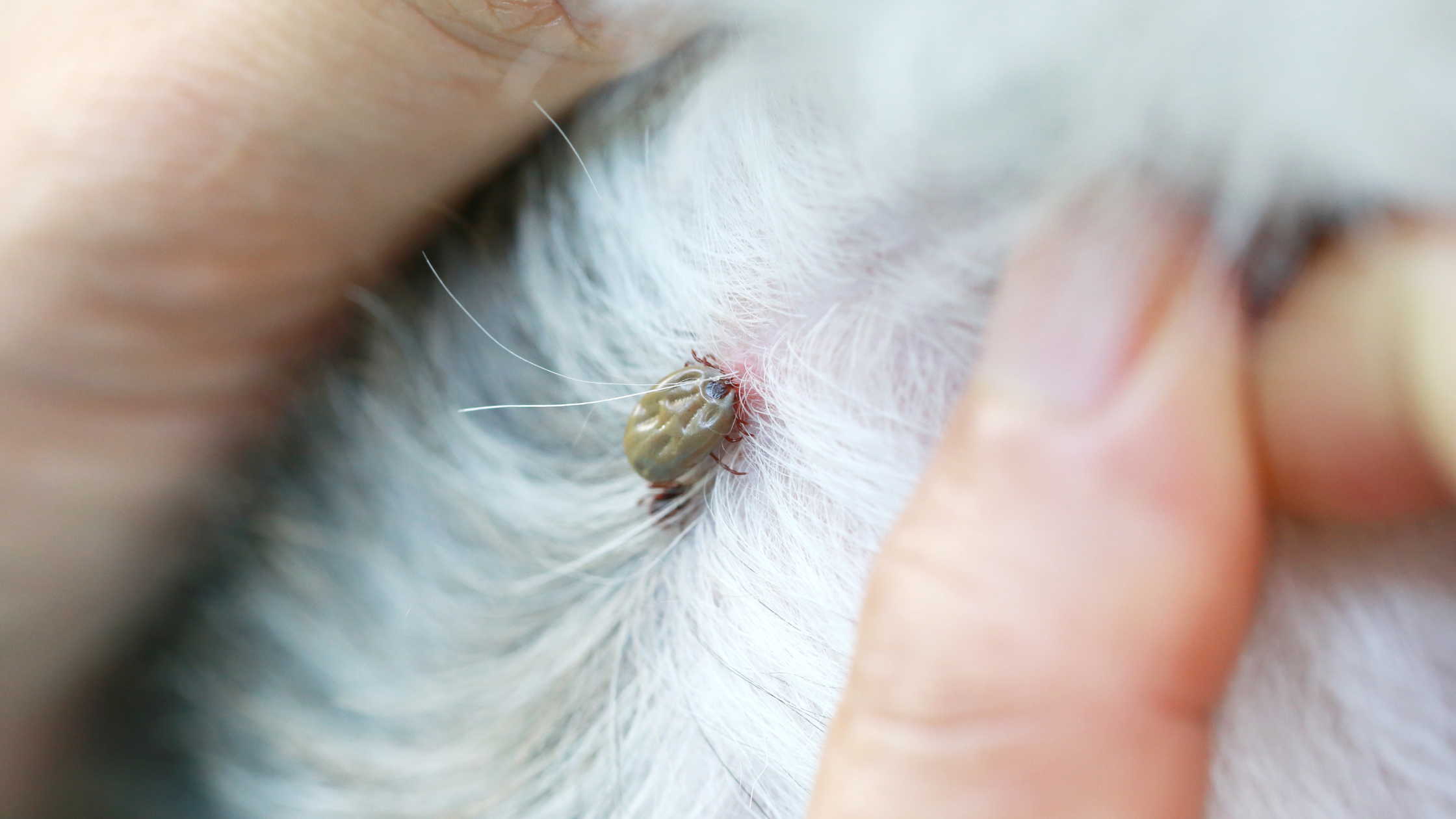
Common Health Issues Caused by Fleas and Ticks
Flea and tick infestations can cause various health issues for dogs, ranging from mild irritation to severe disease. Here are some of the most common problems associated with these parasites:
- Flea Bite Dermatitis: An allergic reaction to flea saliva which can cause intense itching, redness, and inflammation.
- Tapeworms: Fleas can carry tapeworm larvae. If a dog ingests an infected flea while grooming, it can lead to a tapeworm infestation.
- Anemia: In severe flea infestations, especially in young puppies, the loss of blood can lead to anemia, which can be life-threatening if not treated.
- Tick-Borne Diseases: Ticks can transmit several diseases like Lyme disease, causing symptoms such as fever, lameness, and swollen joints.
- Tick Paralysis: Certain tick species produce a toxin that can cause a progressive paralysis in dogs, which resolves once the tick is removed.
It is essential to consult with a veterinarian for appropriate tick products and flea medications tailored to your dog’s specific needs. Regular application of these preventatives is crucial to safeguard your pet from these health issues. Additionally, ensuring your home is vacuumed regularly, and vacuum bags are disposed of properly can help minimise the presence of flea larvae and eggs.
By staying informed and taking these preventative measures, you can help ensure that your dog remains healthy and free from the dangers of fleas and ticks.
Types of Flea and Tick Control
Flea and tick control products come in various forms, each designed to offer protection for your furry friend in different ways. The primary types include flea collars, topical treatments, flea medications like pills and chewables, and tick preventatives such as spot-on treatments and oral medications. Each option has its own method of application and duration of effectiveness. Some work by repelling parasites, while others kill or sterilize them upon contact. Choosing the right type requires considering your dog’s health, lifestyle, and the specific risks they face.
Flea Collars: How They Work and Which Brands to Consider
Flea collars are a popular choice due to their ease of use and long-term protection. They work by releasing chemicals that repel or kill fleas and ticks. The active ingredients spread over your dog’s skin and fur, creating a hostile environment for parasites. Some well-known brands offering flea collars include Seresto, Hartz, and Bayer, each promising various durations of protection, typically up to several months. When choosing a flea collar, it’s important to read the label carefully and ensure it’s the right size and formulation for your pet.
Topical Treatments: Advantages and Disadvantages
Topical treatments, applied directly to the skin, typically between the shoulder blades, are another form of prevention. They work by dispersing the active ingredients across the body’s oils and/or bloodstream to target fleas and ticks. Advantages include their ease of application and the fact that, unlike collars, they cannot be lost or removed accidentally. However, they require careful application, avoiding contact with human skin, and typically cannot be used on wet dogs or allow contact with water for a period after administration. Some dogs may also have skin sensitivities to the ingredients.
Tick Preventatives: Spot-On Treatments and Oral Medications
Tick preventatives in the form of spot-on treatments are applied to the skin and contain ingredients that either repel or kill ticks on contact. Oral tick preventatives, which are ingested by the dog, work by introducing compounds into your pet’s bloodstream that are lethal to ticks. Both methods prevent ticks from attaching and feeding, thus reducing the risk of disease transmission. When deciding between spot-on treatments and oral medications, consider factors such as convenience, the potential for environmental exposure, and your dog’s specific health needs.

Identifying Fleas and Ticks on Your Dog
To maintain your dog’s health, it’s crucial to regularly check for fleas and ticks, which are common external parasites. Fleas are small, dark brown insects that move quickly through your dog’s fur, making them challenging to spot. They are typically less than an eighth of an inch long. Ticks, on the other hand, are larger and become more visible as they engorge with blood. They can vary in color from brown to gray and resemble a small spider or a tiny bump on your dog’s skin. Detection can be achieved through visual inspections and by using a flea comb to run through the fur, especially after walks or time spent outside.
Signs of Flea Infestation: Itching, Redness, and Hair Loss
The presence of fleas on your dog often leads to significant discomfort, characterised primarily by:
- Itching (Pruritus): Your dog may scratch, bite, or lick their skin more than usual.
- Redness and Inflammation: The dog’s skin may become red and inflamed, particularly around the base of the tail, on the belly, and the inside of the thighs.
- Hair Loss (Alopecia): Persistent itching and scratching can result in noticeable thinning or bald patches.
- Flea Dirt: Look for small black specks on the skin, often a sign of flea feces.
Consult your vet if you notice any of these signs since they can also indicate other medical issues.
Identifying Ticks: Size, Colour, and Common Hiding Spots
Ticks are easier to identify when they have attached and started to feed. They can vary in size from as small as a pinhead to as large as a grape when engorged. Here are some characteristics and common hiding spots:
- Size: A tick’s size before feeding is typically between 1mm and 1cm.
- Colour: Colours can vary widely; some are uniformly brown, while others may have distinctive markings or a reddish hue.
- Hiding Spots: Ticks prefer warm, moist areas. Check under your dog’s collar, inside ears, between toes, under tail, and around the head and neck.
Always handle ticks with care, use fine-tipped tweezers for removal, and never crush a tick with your fingers. Dispose of them properly, and make sure to disinfect the bite area and your hands afterwards. If you’re uncertain about tick identification or removal, seek veterinary assistance immediately.
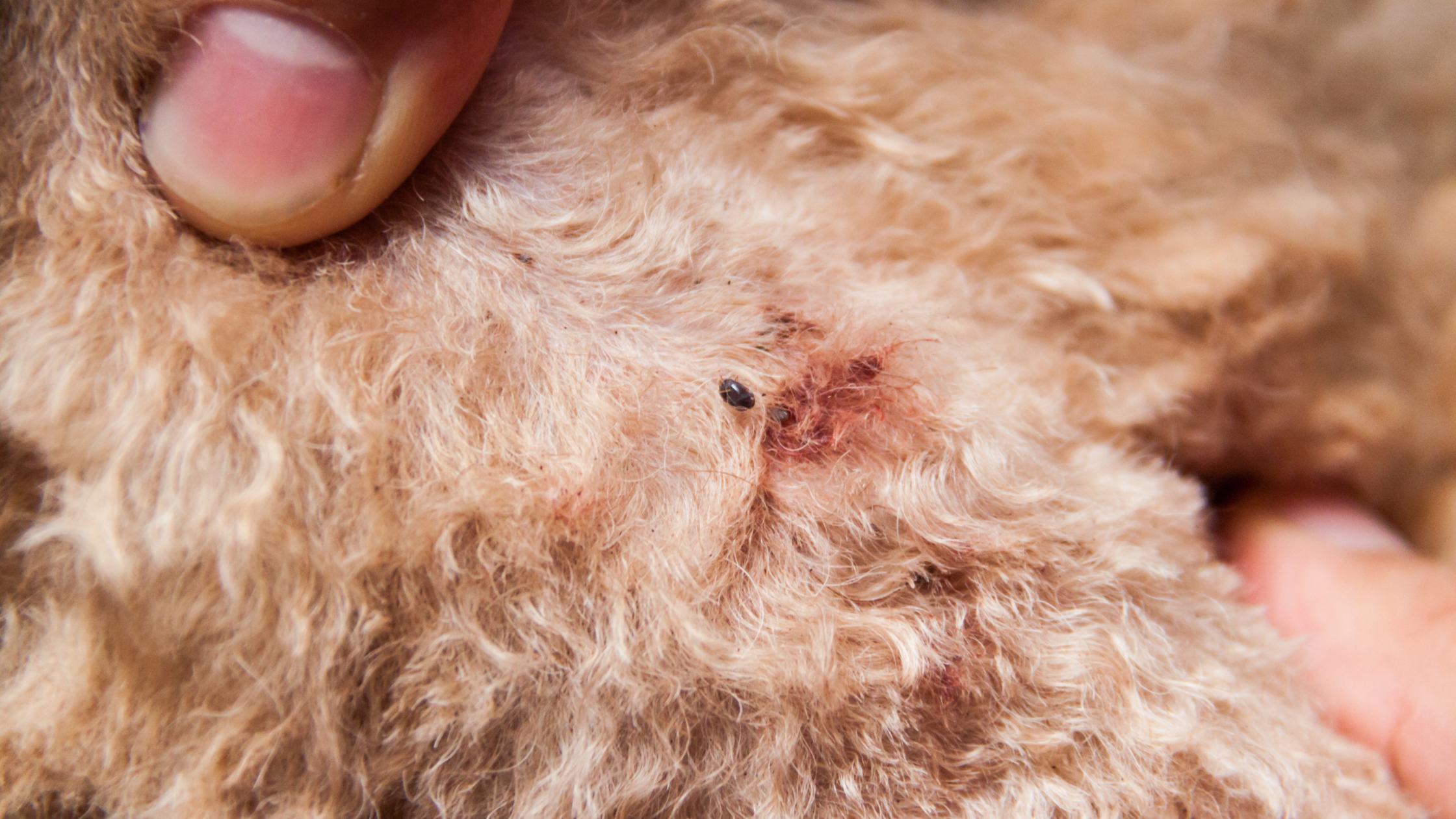
Flea and Tick Lifecycle
Understanding the lifecycle of fleas and ticks is crucial in combating these pesky parasites. Both fleas and ticks progress through several stages in their development, and effectively managing or preventing infestations involves targeting multiple stages of this cycle.
Understanding the Life Stages of Fleas: Eggs, Larvae, Pupae, and Adults
Fleas undergo a complete metamorphosis process that involves four stages – eggs, larvae, pupae, and adults:
- Eggs: After feeding on your dog, an adult female flea can lay up to 50 eggs per day. These tiny, white eggs are easily dropped off into the environment, particularly where your dog sleeps or rests.
- Larvae: In a matter of days, eggs hatch into larvae. These legless creatures avoid light and burrow deep into carpets, upholstery, or cracks in the floor. They feed on organic material, including flea feces rich in blood, known as “flea dirt.”
- Pupae: The larvae spin cocoons, becoming pupae. This stage is particularly resistant to many forms of treatment, as the cocoon can protect the developing flea for months.
- Adults: When the conditions are right (heat, vibrations, carbon dioxide), the adult flea emerges ready to feed, mate, and begin the cycle again.
Understanding these stages is important as certain treatments target specific stages. For example, vacuuming pet areas and washing bedding often targets eggs and larvae, while spot treatments and flea medications typically target adults.
Tick Lifecycle: From Eggs to Larvae, Nymphs, and Adults
Ticks also have a lifecycle comprising of four stages but slightly different from fleas:
- Eggs: A female tick lays thousands of eggs on the ground, which hatch into larvae.
- Larvae: Once hatched, the larvae, sometimes known as “seed ticks,” seek their first blood meal. They are tiny and can be easily missed during checks.
- Nymphs: After the larvae feed and molt, they enter the nymph stage. Nymphs are still quite small and continue to require blood meals to develop.
- Adults: Once nymphs have fed and molted again, they become adult ticks and the cycle is complete. Adults will seek larger hosts to feed and mate on; females will then lay their eggs, starting the process anew.
Each stage in the tick lifecycle requires a blood meal to progress to the next stage, with the exception of eggs. Breaking the cycle typically involves preventing ticks from feeding and using treatments that are effective against both larvae and adults. Environmental management, such as keeping grass trimmed and the removal of leaf litter, also helps disrupt the tick lifecycle.
Flea and Tick-Free Environment
Creating a flea and tick-free environment is essential for the health and comfort of your dog. This involves both preventive measures and active interventions to eliminate these pests from your dog’s living space. By targeting fleas and ticks at every stage of their lifecycle and maintaining a clean environment, you can prevent infestations from taking hold.
Maintaining a Clean Indoor Living Space for Your Dog
To keep your home free of fleas and ticks, it’s vital to maintain cleanliness and regularly disrupt the lifecycle of these parasites where your dog spends most of its time.
- Regular Cleaning: Vacuum your home frequently, especially in areas where your dog likes to relax. This includes their bedding, carpet, and any upholstered furniture. Flea eggs and larvae can be picked up by the vacuum, and using a vacuum with a high-efficiency particulate air (HEPA) filter can be particularly effective. After vacuuming, always dispose of the vacuum bag or empty the canister immediately to prevent any captured flea larvae from developing further.
- Wash Bedding: Wash your dog’s bedding, plush toys, and any removable furniture covers in hot water weekly to kill any flea eggs or larvae residing there.
- Flea Treatments: Utilize flea treatments for your dog, including topical treatments, flea medications, and flea collars, which can all act as an effective defensive barrier. Follow the directions carefully and consult with your veterinarian to choose the best option for your pup.
- Use a Flea Comb: Regularly using a flea comb on your dog can help to physically remove adult fleas, eggs, and flea dirt. It’s a non-invasive method that can also provide a bonding experience for you and your pet.
- Monitor Allergic Reactions: Keep an eye on your dog for signs of allergic reactions, which may indicate a flea bite. If your dog is excessively scratching or showing signs of discomfort, check for fleas and consult a vet for appropriate flea bite remedies.
Tips for Maintaining a Flea and Tick-Free Yard
Your yard is the first line of defense against fleas and ticks as it’s often where your dog is most susceptible to picking up these pests.
- Mow Lawns Regularly: Keep grass short as fleas and ticks thrive in tall grasses, which provide them with moisture and a cool environment.
- Trim Vegetation: Trim bushes and trees to let in more sunlight, as this can help to keep your yard dry and less hospitable to the life cycles of fleas and ticks.
- Clear Debris: Remove leaf litter, clippings, and trash from the yard where ticks and flea larvae may find refuge.
- Use Tick Preventatives: There are environmentally safe tick preventatives and treatments that you can apply to your yard to deter these parasites.
- Create a Barrier: If possible, install a barrier between your yard and wooded areas or places with tall grasses to prevent wildlife carriers of ticks from coming too close to your home.
By following these guidelines, you create an inhospitable environment for fleas and ticks, reducing the chances that your dog will encounter these pests. Remember that consistent efforts are required to maintain a flea and tick-free environment both inside and outside your home.
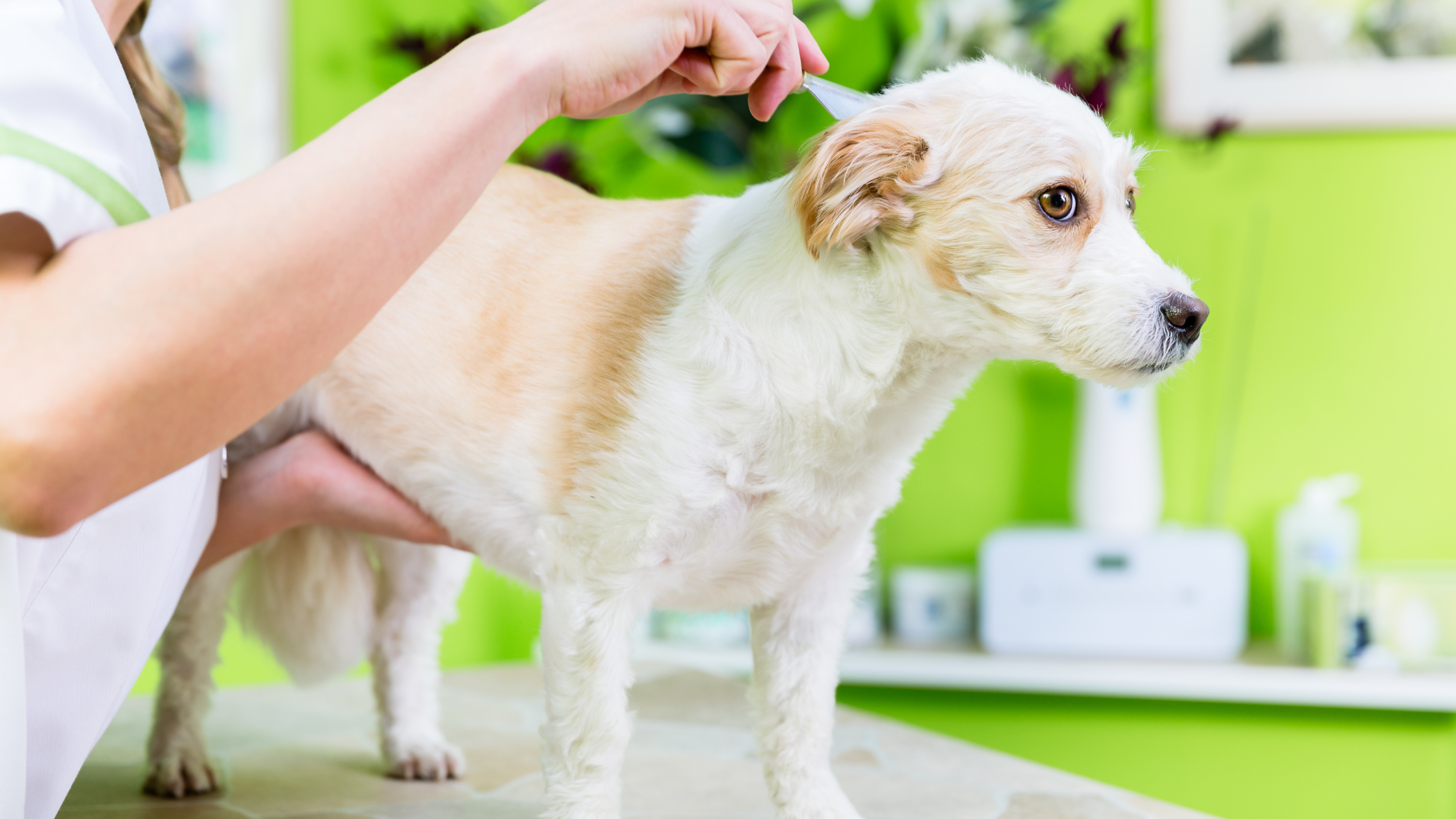
Safe and Effective Flea Comb Techniques
A flea comb is an essential tool that can help you detect and eliminate fleas from your dog’s coat. To effectively use a flea comb:
- Prepare Your Space: Choose a well-lit area and have a bowl of soapy water nearby to drown any fleas that you comb off.
- Groom Your Dog: Before combing, make sure to brush your dog to remove any mats or tangles that could trap fleas.
- Comb Carefully: Gently comb through your dog’s fur, starting from the head and moving towards the tail. Pay special attention to areas where fleas like to hide, such as the neck, belly, and base of the tail.
- Dip and Rinse the Comb: After each pass through the fur, dip the comb into the soapy water to remove any fleas, eggs, or flea dirt.
- Dispose of Fleas: Properly dispose of the fleas in the soapy water, ensuring they cannot escape and re-infest your dog.
Regular combing, in conjunction with flea treatments, can significantly reduce the likelihood of flea infestation.
Proper Tick Removal: Tools and Techniques
Removing a tick from your dog requires care to avoid leaving the tick’s head embedded in your dog’s skin, which could lead to infection. Follow these steps for safe tick removal:
Tools You Will Need:
- Fine-tipped tweezers or a specially designed tick removal tool.
- Gloves to protect yourself from potential tick-borne diseases.
- Antiseptic for wound cleaning.
Tick Removal Procedure:
- Wear gloves to avoid contact with the tick.
- Grasp the tick as close to the skin’s surface as possible with the tweezers.
- Pull upward with steady, even pressure—do not twist or jerk the tick, as this can cause parts to break off and remain in the skin.
- After removing the tick, clean the bite area and your hands with rubbing alcohol or soap and water.
- Dispose of the tick by submersing it in alcohol, placing it in a sealed bag/container, wrapping it tightly in tape, or flushing it down the toilet. Never crush a tick with your fingers.
After removal, watch the area for signs of infection and consult your veterinarian if any unusual symptoms or irritation develop.

Natural Flea Repellents for Dogs
In our journey to maintain a flea and tick-free life for our dogs, it’s worth exploring natural alternatives that avoid harsh chemicals. Natural flea repellents can be effective and safe, making them an excellent choice for pet owners looking to minimise their pets’ exposure to synthetic products.
Essential Oils: Some essential oils are known for their pest-repellent properties and can be safely used around dogs in diluted forms. Oils such as lavender, lemongrass, and cedarwood are not only pleasant smelling but also naturally deter fleas and ticks. It’s important to dilute essential oils with a carrier oil such as coconut oil and to always perform a patch test to ensure your dog doesn’t have an allergic reaction.
Diatomaceous Earth: Food-grade diatomaceous earth can be used as a powder on your dog’s coat to kill fleas and ticks. It works by dehydrating the insects. It’s non-toxic, but make sure it doesn’t get inhaled by you or your dog during application.
Apple Cider Vinegar: A solution of apple cider vinegar and water can be sprayed on your dog’s fur to create an acidic environment that repels fleas. However, this should not be used on dogs with open cuts or wounds because it can sting.
Nematodes: These microscopic worms can be introduced into your yard to target flea larvae, naturally reducing the flea population without using chemical treatments.
Amberdam Flea Collars: Designed for both dogs and cats, these beautiful, natural, calming amber collars derived from genuine Baltic Amber are fossilised natural tree resin, abundant in aromatic terpenes. These pet collars emit resinous aromas when heated or rubbed naturally against your pet’s neck. The friction with their fur absorbs the resinous scent, establishing a natural aromatic repellent.
Regular Grooming and Baths: Sometimes, the simplest methods are the most effective. Regular grooming and washing your dog with natural, hypoallergenic shampoo can help remove fleas and ticks from your dog’s coat.
By incorporating these natural solutions into your flea and tick prevention routine, you can reduce the use of chemicals and provide a safer environment for your pet and your family. Always consult your veterinarian before trying new treatments on your dog to ensure they are safe and suitable for your pet’s health.
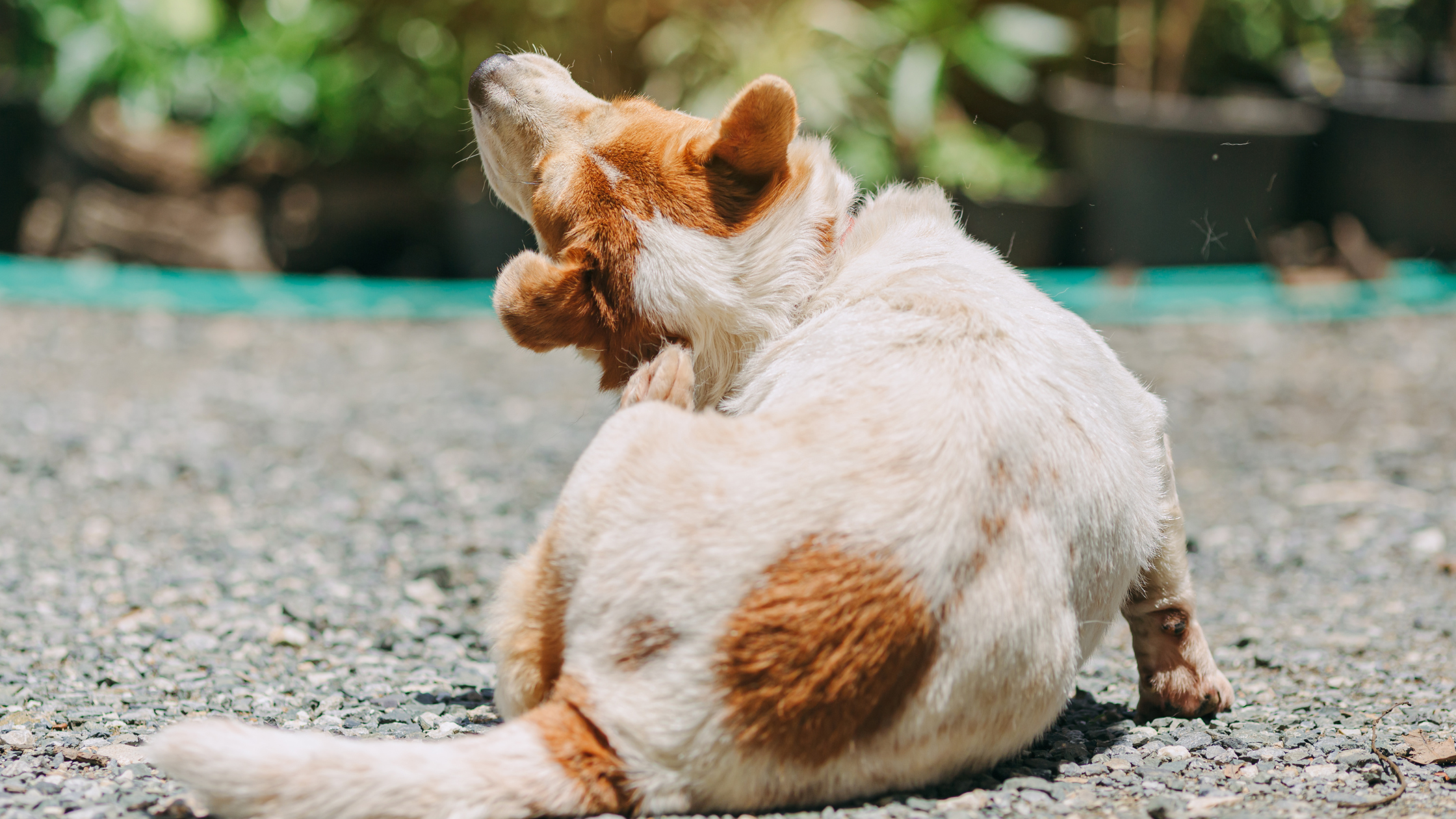
Preventing Allergic Reactions to Fleas and Ticks
Allergic reactions to fleas and ticks are not only uncomfortable for your dog but can also lead to more severe health issues if left untreated. Flea bite dermatitis and tick hypersensitivity are common allergic reactions in which a dog’s immune system overreacts to the saliva of these pests. To prevent these conditions, a comprehensive flea and tick control plan is crucial. This includes the regular use of flea collars, topical treatments, and flea medications. Additionally, keeping your dog away from high-risk areas such as tall grasses where these parasites thrive is a proactive approach to prevention. Ensure your home and your dog’s environment are kept clean by frequent vacuuming, especially with vacuum bags that can capture flea larvae and eggs. Lastly, maintain a regular grooming schedule for your dog using a flea comb to monitor and remove any pests promptly.
Common Allergic Reactions and Symptoms
Flea bite dermatitis and tick bites can trigger allergic reactions in dogs, leading to symptoms such as excessive itching, red or irritated skin, and hair loss. In some cases, the constant scratching can cause open sores and increase the risk of secondary infections. Other symptoms may include swelling around the bite site, hives, and in severe cases, anaphylactic shock, a life-threatening condition requiring immediate veterinary care. It’s important to observe your dog regularly for these signs, especially after spending time outdoors, and consult your veterinarian if any symptoms are noted.
Managing Allergies with Medications and Natural Remedies
When dealing with allergies caused by fleas and ticks, medications prescribed by your veterinarian are often the most reliable form of treatment. These can include antihistamines, corticosteroids, and, if infections occur, antibiotics. Some dog owners also explore natural remedies, which can serve as complements to traditional treatments. Omega-3 fatty acids, for example, may help reduce inflammation and improve skin health. Additionally, bathing your dog with hypoallergenic or medicated shampoos can provide relief from itching. Always consult with a veterinarian before starting your dog on a new medication or supplement to ensure it’s safe and won’t interact negatively with other treatments.
Frequently Asked Questions about Flea and Tick Prevention
The frequency with which you should treat your dog for fleas and ticks depends on various factors, including the type of preventative used, your location, and your dog’s lifestyle. Typically, a monthly schedule is recommended for most flea and tick products. Some flea collars can last longer, offering protection for several months. It’s vital to follow the product’s instructions and consult your veterinarian for advice tailored to your pet’s specific needs.
|
Product Type |
Treatment Frequency |
|---|---|
|
Topical Treatments |
Every 30 days |
|
Oral Flea Medications |
Every 30 days or as prescribed |
|
Flea Collars |
Every 3 to 8 months |
|
Tick Preventatives |
Every 30 days |
Remember to mark your calendar or set reminders to maintain consistent protection against these pests.
Can Fleas and Ticks Transmit Diseases to Humans?
Yes, fleas and ticks can transmit diseases to humans. Fleas are known for spreading the bacteria that causes cat scratch fever and can also carry tapeworms. Ticks, on the other hand, are notorious for transmitting Lyme disease, Rocky Mountain spotted fever, and several other tick-borne illnesses. It’s essential to handle infestations promptly and with care to minimise the risk of disease transmission to humans. Always wear gloves when dealing with infested animals or environments and wash your hands thoroughly after contact.
What to Do If My Dog Has a Severe Reaction to Flea or Tick Bites?
If your dog has a severe reaction to flea or tick bites, such as intense itching, swelling, hives, or signs of anaphylactic shock (difficulty breathing, collapse), it’s imperative to seek veterinary care immediately. For immediate relief:
- Remove any visible ticks using fine-tipped tweezers.
- Clean the bite area gently.
- Apply a cold compress to soothe the area if recommended.
- Administer any prescribed medications for allergic reactions, if previously supplied by a veterinarian.
Keep your vet informed and report all the symptoms your dog exhibits. More severe cases may require emergency treatment and supportive care to stabilise your dog’s condition




